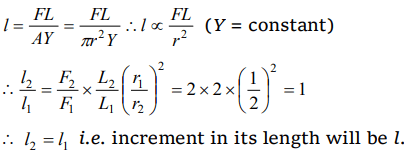1. The elastic limit for a gas
a) Exists
b) Exists only at absolute zero
c) Exists for a perfect gas
d) Does not exist
Explanation: Exists
2. If Young's modulus for a material is zero, then the state of material should be
a) Solid
b) Solid but powder
c) Gas
d) None of the above
Explanation: Y is defined for solid only and for powders, Y = 0
3. Liquids have no Poisson's ratio, because
a) It has no definite shape
b) It has greater volume
c) It has lesser density than solid
d) None of the above
Explanation: It has no definite shape
4. A wire of length L and radius r is rigidly fixed at one end. On stretching the other end of the wire with a force F, the increase in its length is l. If
another wire of same material but of length 2L and radius 2r is stretched with a force of 2F, the increase in its length will be
a) l
b) 2l
c) \[\frac{l}{2}\]
d) \[\frac{l}{4}\]
Explanation:

5. In steel, the Young's modulus and the strain at the breaking point are \[2\times10^{11} Nm^{-2}\] and 0.15
respectively. The stress at the breaking point for steel is therefore
a) \[1.33\times10^{11} Nm^{-2}\]
b) \[1.33\times10^{12} Nm^{-2}\]
c) \[7.5\times10^{-13} Nm^{-2}\]
d) \[3\times10^{10} Nm^{-2}\]
Explanation:

6. Which of the following statements is correct
a) Hooke's law is applicable only within elastic limit
b) The adiabatic and isothermal elastic constants of a gas are equal
c) Young's modulus is dimensionless
d) Stress multiplied by strain is equal to the stored energy
Explanation: In accordance with Hooke’s law
7. The force required to stretch a steel wire of \[1 cm^{2}\]
cross-section to 1.1 times its length would be \[\left(Y=2\times10^{11} N\right)\]
a) \[2\times10^{6} N\]
b) \[2\times10^{3} N\]
c) \[2\times10^{-6} N\]
d) \[2\times10^{-7} N\]
Explanation:

8. Which one of the following substances possesses the highest elasticity
a) Rubber
b) Glass
c) Steel
d) Copper
Explanation: Steel
9.Which one of the following quantities does not have the unit of force per unit area
a) Stress
b) Strain
c) Young's modulus of elasticity
d) Pressure
Explanation: Because strain is a dimensionless and unitless quantity
10. A copper wire and a steel wire of the same diameter and length are connected end to end and a force is applied, which stretches their combined
length by 1 cm. The two wires will have
a) Different stresses and strains
b) The same stress and strain
c) The same strain but different stresses
d) The same stress but different strains
Explanation: Stress = \[\frac{Force}{area}\]
In the present case, force applied and area of cross-section of wires are same, therefore stress has to be the same.
Strain = \[\frac{Stress}{Y}\]
Since the Young’s modulus of steel wire is greater than the copper wire, therefore, strain in case of steel wire is less than that in case of copper wire.